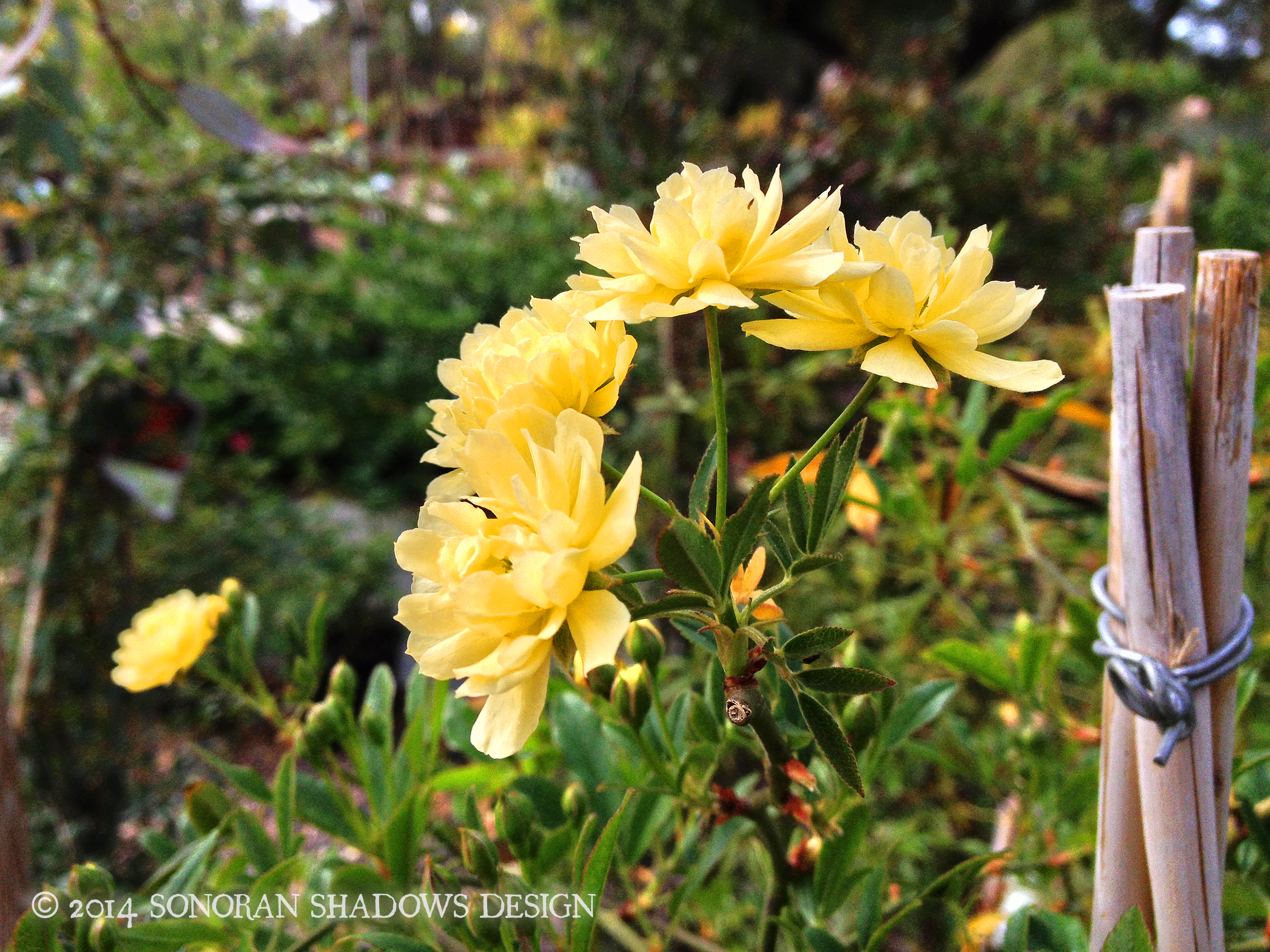Most of the Rosa banksiae varieties will take part shade or full sun (preferably sun for more robust shows of flowering). It is also tolerant of our winter temps, and is virtually pest-free here in Phoenix! Lady Bank's is an excellent choice for covering those stark areas along your property fence and breaking-up otherwise monotonous and utilitarian parts of your landscape. The use of multiple vines at key points along the periphery of your yard will provide vertical interest and rhythm in those spaces that are often times an afterthought in the design. Let it crawl up a series of sturdy decorative trellises along your back wall to create rhythm and unify your yard through repetition of a simple element. Grow it over a custom designed arbor strategically placed as an arching transitional piece between your outdoor living spaces. Or, let Lady Banks’ work its magic on your slatted pergola … give it some support near your structure’s columns and utilize the vine as a living texture that provides a lush green canopy and an added dabbling of shade! Allow it to hang over your architectural walls and patio structure like a natural veil, to break-up and soften those hard-lined edges. The possibilities with this vine are almost limitless! Whatever its purpose, this gorgeous old-fashioned vine will lend a 'romantic' feel to your garden, and will be truly at-home amidst rustic-themes, Italianate-style landscapes, or Japanese Gardens. She looks good even in more arid plant arrangements too! If you're not totally sold on the desert aesthetic, and are going for a more transitional plant palette, Lady Bank's Rose should certainly be on your list of plants to consider!
There are single and double-flower forms. Native to China, Rosa banksiae 'normalis' is typically believed to be the original, wild form of this vine, with a single white flower. However, R. banksiae banksia (R. banksiae alba-plena), a double white-flowering variety, was the first of these vines to be described botanically. This variety was first introduced in England, in 1807. Mr. William Kerr brought this plant to Kew Gardens, England from Canton, China. Here it was rightfully dubbed "Lady Bank's" after the wife of Sir Joseph Banks, the director of Kew at the time, and the financier of many expeditions into Asia. Plants that eventually reached Kew Gardens would be named for Lady Banks. Though originating from China, it was the Botanical Gardens of Calcutta, formerly known as the Royal Botanic Garden, which brought the double-flowering variety into public interest. In 1824 John Damper Parks, who'd been sent to Asia to collect samples for the Royal Horticultural Society, sent this plant back to England on a trading vessel returning to Lowther Castle. It was that shipment that gave us this rosy vine that we love so much today. The variety 'Lutea', a subspecies of Rosa banksiae, wouldn't be discovered until 1877, by Regel, and later introduced to France by Pierre Delevay in 1884.
Much closer to home, botanists, horticulturalists, and plant enthusiasts alike are witness to "The Tombstone", a very old double-white Lady Banks' that was planted in 1855. Located near the town of its namesake, Tombstone, Arizona, this vine covers nearly 8,000 square feet, and has been identified by The Guinness Book of World Records as the largest rose plant in the world. Fear not though! In most residential and commercial landscape applications, with a regular drip irrigation system & schedule, these vines typically sprawl from 15-20 feet, but can reach upwards of 50' (if left unpruned). Seasonal pruning IS encouraged, as these vines appreciate a light trimming after the floral show is over, perhaps mid-late July time frame. The blooms DO occur on old wood, so keep this in mind and be selective with what you cut back. During the first year after planting, you'll want to follow a fairly regular irrigation schedule to ensure the vine develops a deep, extensive root system. A general purpose fertilizer is fine for promotion of healthy growth. Though 'Lutea' loves to sprawl and 'wants' to grow out and up, it will need support! Ensure that you've planted it near a ridged vertical structure that will support its weight and maximize its floral show!

 RSS Feed
RSS Feed